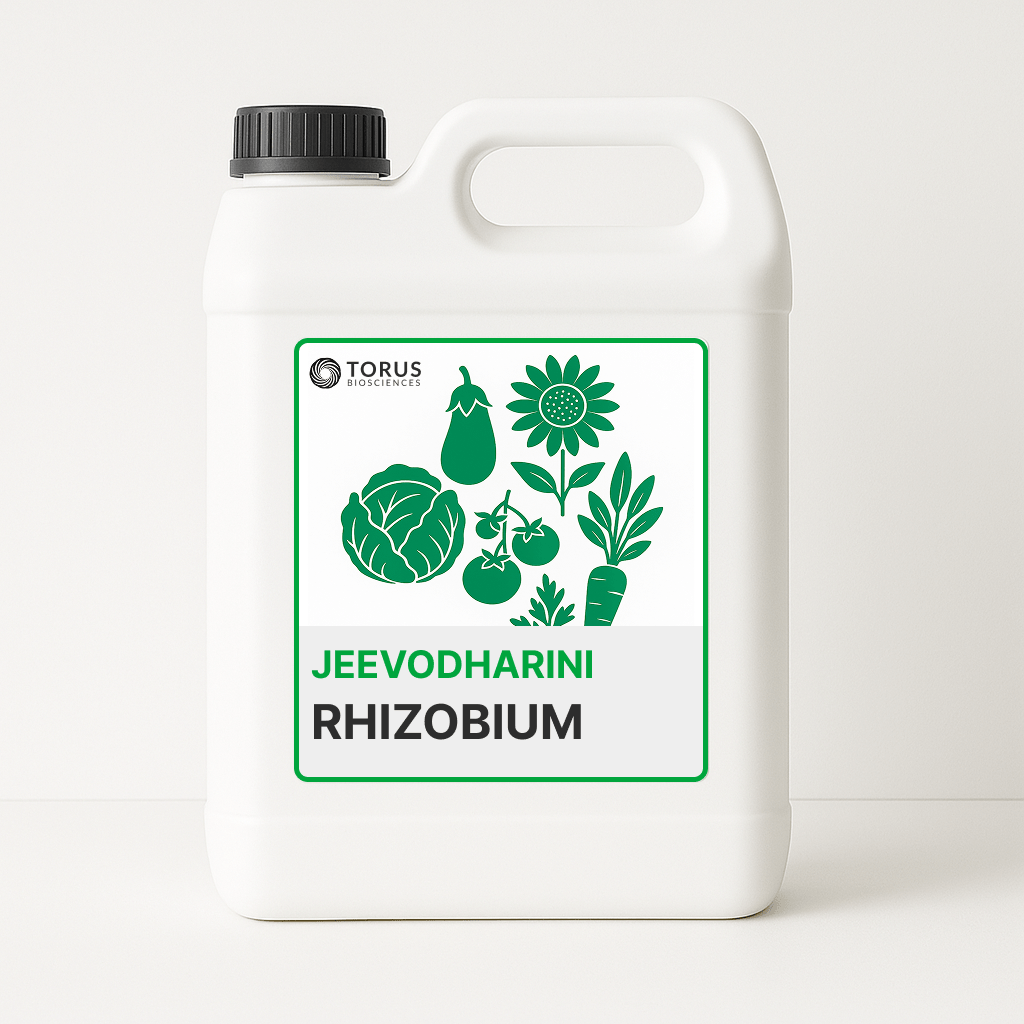
Rhizobium
Contains symbiotic nitrogen-fixing bacteria that form root nodules in leguminous plants, providing significant nitrogen benefits and reducing dependency on chemical fertilizers.

Rhizobium is a genus of symbiotic nitrogen-fixing bacteria that form specialized structures called nodules on the roots of leguminous plants. Inside these nodules, Rhizobium bacteria convert atmospheric nitrogen into plant-available forms, establishing a mutually beneficial relationship where bacteria receive carbon compounds from the plant while providing fixed nitrogen in return.
Extensive field research demonstrates that proper Rhizobium inoculation can significantly increase nodulation, nitrogen fixation, and yield in legume crops, while simultaneously improving soil fertility for subsequent crops in rotation systems.
Benefits
-
Symbiotic Nitrogen Fixation: Rhizobium bacteria form a true symbiotic relationship with legume roots, converting atmospheric nitrogen into plant-available forms within specialized nodules. This process can fix 50-200 kg N/ha annually, significantly reducing or eliminating the need for nitrogen fertilizer in legume crops.
-
Complete Nitrogen Self-Sufficiency: Unlike associative nitrogen-fixers, properly nodulated legumes with effective Rhizobium strains can derive 70-90% of their nitrogen requirements from biological fixation, eliminating the need for nitrogen fertilizers under optimal conditions.
-
Enhanced Protein Content: Legumes inoculated with effective Rhizobium strains typically show 15-25% higher seed protein content due to improved nitrogen nutrition throughout the growing season, enhancing both yield and nutritional quality of harvested grains.
-
Residual Soil Nitrogen Benefit: Beyond the direct benefits to the host legume, Rhizobium-fixed nitrogen remains in crop residues and root systems, providing 30-80 kg N/ha to subsequent crops in rotation systems, reducing fertilizer requirements for following non-legume crops by 30-50%.
-
Improved Soil Health: Legume-Rhizobium symbiosis contributes to improved soil structure through increased organic matter inputs from both above and below-ground biomass. This biological nitrogen input is more sustainable than chemical sources, reducing soil acidification that occurs with repeated ammonium-based fertilizer use.
-
Balanced Plant Growth: The gradual release of biologically-fixed nitrogen throughout the growing season promotes balanced vegetative growth and reproductive development in legumes, reducing problems with excessive vegetative growth that can occur with high chemical nitrogen applications.
-
Climate Resilience: Well-nodulated legumes show improved drought tolerance compared to non-nodulated plants reliant on soil nitrogen uptake. The symbiotic relationship helps maintain nitrogen nutrition even during periods of limited soil moisture when mass flow of nutrients is restricted.
Suitable Crops
Rhizobium strains demonstrate host-specific relationships with leguminous crops:
-
Pulse Crops: Chickpea, pigeon pea, lentil, mung bean, and other grain legumes form effective symbiosis with specific Rhizobium strains, with inoculation increasing yields by 20-40% in soils lacking appropriate native populations.
-
Forage Legumes: Alfalfa, clover, and other perennial forage legumes establish long-term symbiotic relationships, fixing 150-200 kg N/ha annually when properly nodulated, supporting multiple harvests without nitrogen fertilization.
-
Soybean: This globally important crop forms specific relationships with Bradyrhizobium japonicum (a related nitrogen-fixing bacterium), fixing 60-180 kg N/ha annually and typically showing 20-30% yield increases with proper inoculation in new cultivation areas.
-
Groundnut/Peanut: Forms effective symbiosis with specific Rhizobium strains, with proper inoculation improving both pod yield and quality parameters while contributing residual nitrogen to subsequent crops.
-
Green Manure Legumes: Sesbania, sunhemp, and other cover crop legumes maximize nitrogen fixation when properly inoculated, accumulating 80-120 kg N/ha in 45-60 days when used as green manure crops.
For optimal results, apply crop-specific Rhizobium inoculants directly to seeds before planting or into the seed furrow at planting time. Ensure the correct strain for your specific legume crop, as Rhizobium bacteria demonstrate high host specificity, with each species or strain effectively nodulating only certain legume hosts.
Maximum benefits occur in soils where appropriate native Rhizobium populations are absent or insufficient, particularly in fields without recent legume cultivation history. The symbiosis works most effectively in well-aerated soils with neutral pH (6.0-7.0) and adequate phosphorus availability, which is essential for the energy-intensive nitrogen fixation process.
Key Microorganism
Rhizobium leguminosarum: This species forms effective symbiotic relationships with a range of legume crops including peas, lentils, and various beans. The bacteria recognize specific flavonoid signals from compatible host plants, triggering nodule formation and nitrogen fixation processes. Inside functional nodules, the bacteria differentiate into bacteroids containing the nitrogenase enzyme complex that converts atmospheric N₂ into ammonia. Effective nodulation can fix 50-200 kg N/ha annually depending on the legume species, soil conditions, and growth duration.
Mechanism of Action
-
Signal Exchange and Recognition: The symbiotic relationship begins with a molecular dialogue between plant and bacteria. Legume roots release specific flavonoid compounds that activate bacterial nodulation (nod) genes, which in turn produce lipochitooligosaccharide signals (Nod factors) that trigger root hair curling and cortical cell division in the plant.
-
Infection and Nodule Development: Rhizobia enter the plant through root hairs, forming infection threads that grow through plant cells while stimulating the formation of a specialized organ (nodule) with differentiated plant tissues including vascular connections to transport nutrients to and from the nodule.
-
Bacteroid Differentiation: Inside nodules, bacteria transform into enlarged, often branched bacteroids that express the nitrogenase enzyme complex. The plant provides leghemoglobin (giving functional nodules their pink color), which regulates oxygen concentration to protect oxygen-sensitive nitrogenase.
-
Biological Nitrogen Fixation: The bacteroids convert atmospheric N₂ to ammonia through the nitrogenase enzyme complex in an energy-intensive process: N₂ + 8H⁺ + 8e⁻ + 16ATP → 2NH₃ + H₂ + 16ADP + 16Pi
-
Nutrient Exchange: The plant provides carbon compounds (primarily malate) to fuel the energy-intensive nitrogen fixation process, while bacteroids export fixed nitrogen (primarily as ammonia or amino acids) directly to plant tissues.
-
Nodule Maintenance and Senescence: Active nodules continuously regulate their metabolism in response to plant nitrogen status. When soil nitrogen is abundant or the plant shifts to reproductive stages, nodules gradually senesce, releasing their nitrogen content to support seed development.
Storage and Usage Instructions
For detailed application instructions, please refer to our Seed Treatment Guide or Root Application Guide depending on your preferred application method.
Available Variants




Boost productivity with our sustainable biological solutions.
Trusted by agricultural and waste management professionals for superior results.
Request pricing & availability